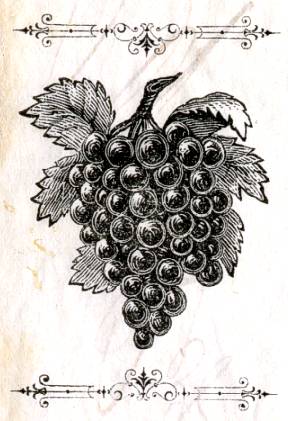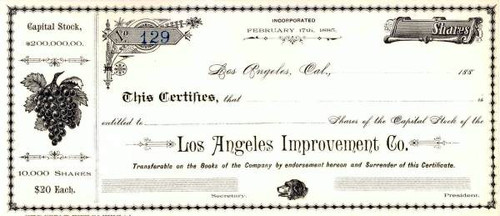Beautifully printed certificate from the Los Angeles Improvement Company issued in 1886. This historic document was printed by Kingsley, Barnes & Company, L.A. and has an ornate border around it with a vignette at left of a bunch of grapes with leaves attached and a small vignette at bottom center of a dog's head. This item is hand signed by the Company's President, Jesse Yarnell and Secretary, Edward A. Hall and is over 138 years old.

Certificate Vignette
In Los Angeles the first Cable Railroad to open was the Second Street Cable Railroad line in October 1885 on Second Street from Spring to Texas Street (Belmont Avenue). The line opened with three "dummy" grips and three trailers, each seating about a dozen riders. The primary promoters of the project were officers of the Los Angeles Improvement Co. who reportedly sold almost all of their 1400 available lots within the first year after the line opened. Poor's Directory of Railway Officials, 1887 P. 233 Los Angeles Improvement Company owned the Second Street Cable R.R. Co. operates 1.6 miles of road, owns 6 dummies and 6 cars. Directors, W. S. Newhall, San Francisco, Cal; Jas. McLaughlin, Jesse Yarnell, H. C. Witmer, Edward A. Hall, Los Angeles, Cal. -- Edward A. Hall, Pres., Jas. McLaughlin, Vice-Pres., H. C. Witmer, Sec., Jesse Yarnell, Treas., Edward A. Hall, Supt., F. F. Field, Pur. Agt.. -- GENERAL OFFICE, 33 South Spring St., Los Angeles, Cal. Jesse Yarnell came to Los Angeles in 1866. He was one of the earliest newspaper editors and publishers in California. He helped found at least two of the newspapers which now stand out as among the greatest institutions of the "fourth estate" on the Pacific Coast. He was a man of varied capabilities and varied services. He was an important personage in Los Angeles when it was just beginning its modern development. His influence was not dwarfed as the city grew and expanded, and even in later years he was counted upon as one of the men whose support was essential to many forward movements, and whose influence was indispensable in the better life of the community. Los Angeles From The Mountains To The Sea JOHN STEVEN McGROARTY WITH SELECTED BIOGRAPHY OF ACTORS AND WITNESSES OF THE PERIOD OF GROWTH AND ACHIEVEMENT THE AMERICAN HISTORICAL SOCIETY CHICAGO AND NEW YORK 1921 Jesse Yarnell died at his home, at 134 South Bonnie Brae street, January 19, 1906, being then sixty-nine years of age. He was born June 20, 1837, at Gratiot, in Licking county, near the Muskingum county line, in the state of Ohio. As a boy he learned the printer's trade at Zanesville, Ohio.
He worked there in the newspaper business about three years, and in 1862 came to California, settling at Placerville, the old mining center originally called Hangtown. He bought a controlling interest in the Placerville Daily News, the first paper of Placerville, and was identified with its management until 1866. On coming to Los Angeles in the latter year Mr. Yarnell started the weekly Republican. A year later he sold the material of this plant, and eventually it was used for the publication of the Evening Express, a newspaper launched by Mr. Yarnell and his brother George, together with Mr. George Tiffany, John Painter and Miguel Varilla. Later Mr. Yarnell, associated with T. J. Caystile and W. W. Brown, started the Weekly Mirror. Subsequently Nathan Cole came to Los Angeles and established the Daily Times, which he sold to the Mirror Company.
The Mirror was finally purchased by Col. H. G. Otis and associates and incorporated in the Times-Mirror Company. Thar brings the institution within the record of the history of the present Los Angeles Times, one of the greatest daily papers in the country. Under the direction of Mr. Yarnell, the Weekly Mirror had an influential and prosperous career and was well fitted to be one of the corner stones of the Los Angeles Daily Times of the present. The late Mr. Yarnell was a lifelong advocate and stanch supporter of prohibition. Throughout his newspaper career he never neglected an opportunity to make his journals express his views on that subject. After selling the Mirror he associated himself with Commodore Rufus R. Haines and Julius Martin in establishing the Western Wave, which was conducted as an out-and-out prohibition paper. After a year they sold the Wave, and it was finally merged into what was the California Voice, the representative prohibition paper on.the Pacific Coast. Mr. Yarnell was also identified with the organization of the old firm of Kingsley & Barnes, later Kingsley, Barnes & Nenner Company, and was one of the incorporators of the Los Angeles Improvement Co. and the first president of the first cable street railroad into Los Angeles, the old Second street line, which started at Second street on Spring and terminated on Belmont avenue. This old cable line played an important part in the development of the hill section of Los Angeles. His part in these varied enterprises indicates the characteristic most prominently associated with Mr. Yarnell in the minds of his associates, his broad-minded judgment and public spirit. By a degree of justice his name belongs among the builders of modern Los Angeles. He assisted in laying out several additions to subdivisions in and around Los Angeles. He was one of the incorporators of the old Indiana colony, the foundation of the beautiful city of Pasadena. He also helped re-estnblish the Troy Laundry Company of Los Angeles, which became one of the best institutions of its kind in the southern part of the state. He was secretary of the company for eight years.
He was also president of the Portland Land & Water Company and of the Richfield Land & Water Company, and in later years became interested in the oil development in his section of the state. As a worker of the prohibition party he was several times nominated for office on that ticket and was three times elected to represent California on the National Party Committee and also on the State Committee, and chairman of the county organization. He was a member of the Los Angeles Pioneers' Association and held one of the highest offices in the state organization of the Good Templars. For over twenty-five years he was an active member of Merrill Lodge, I. O. G. T. The late Mr. Yarnell was heir to a splendid inheritance of character from his ancestors. His mother was a direct descendant of Oliver Cromwell, a near relative of ex-President Zachary Taylor and Bayard Taylor. At Placerville, January 18, 1865, Mr. Yarnell married Miss Susan Caystila, daughter of Thomas and Esther (Lea) Caystile. She came to California with her parents around the Isthmus of Panama in 1855, when only nine years of age. After they came to Los Angeles Mr. and Mrs. Yarnell lived on a five-acre tract at the present site of Figueroa and Pico streets, and for many years their home was the present family residence at First and Bonnie Brae streets. The three daughters of the family still occupy that family residence.
The old church at Placerville where Mr. and Mrs. Yarnell were married is still standing. Mrs. Yarnell, who died in October, 1919, was not only a Los Angeles pioneer, but distinguished for many rare qualities of beauty and generosity. She moved in the best social circles, but much of her time was given to charity and she befriended and worked for children in particular. Her father was born on the Isle of Man, and her mother in Liverpool, England. Thomas Caystile was one of the early settlers at Placerville. The original family stock of the Caystiles goes back to ancient Spain. The Yarnells were of English descent, and one of the name was a surveyor with George Washington. Mr. and Mrs. Yarnell had five children, the youngest, Ramona, dying at the age of eighteen. The only son is Ellis T. Yarnell. The three daughter? are Esther, Katherine and Mrs. Jesse Y. Kimball. They are all native Californians, Mrs. Kimball being a native of Placerville, while the others were born at Los Angeles.
February 1, 1873 - Jesse Yarnell, T. J. Caystile and Samuel J. Mathes published Los Angeles Weekly Mirror advertising sheet; printed by Mirror Printing Office and Book Bindery; December 4, 1881 - Nathan Cole Jr. & Thomas Gardiner launched Los Angeles Daily Times, went bankrupt; January 1, 1882 - Mathes assumed editorial control; August 1, 1882 - former Union army lieutenant colonel Harrison Gray Otis assumed Times editorship and part control ( bought a quarter interest in Los Angels Daily Times for $6,000); October 1884 - acquired holdings of Yarnell, A.W. Francisco; Colonel Henry H. Boyce acquired Mathes's interest; gained control of Mirror and Mirror's printing company; incorporated Times-Mirror Company; 1886 - Otis bought Boyce's half-interest in paper, named himself president, general manager, editor-in-chief; 1891 - Weekly Mirror incorporated with Saturday Times, became Los Angeles Saturday Times & Weekly Mirror; 1965 - first newspaper to publish over 4 million classified advertisements in one year, first US newspaper to publish over 100 million lines of advertising in year; 1970 - bought controlling interest in Newsday; 1979 - acquired Hartford (Connecticut) Courant; 1980 - acquired Denver Post for $95 million; 1986 - acquired Baltimore Sun, Evening Sun, WMAR-TV for $600 million; June 2000 - acquired by Tribune Company (Chicago Tribune) in $8.3 billion takeover.
Chutes and Luna Park In 1887, D. V. Waldron purchased 35 acres on the southwest corner of Main and Washington Streets near downtown Los Angeles. He established a connection to the streetcar line in order to bring business to the area. Calling the park Washington Gardens, he built a small theater, dance pavilion, and meandering, tree-lined walkways, along with an ostrich farm. However, the park acquired a reputation as a haunt for disreputable characters, and the park fell into disrepair. Toward the end of 1899, the Los Angeles Improvement Company acquired a long-term lease on the property, changed the name to Chutes Park, and made plans to create an amusement park centered around Paul Boynton's Shoot the Chutes ride, in which boats would slide down a ramp into a small artificial lake. In 1900, The company built a baseball field, which was the home of the Angels baseball team until 1925. Other attractions included a merry-go-round, Japanese tea house, shooting gallery, bowling alleys, children's playground, daily hot air balloon rides, an animal enclosure, and other carnival-style entertainments. During 1903-1906, a steel-framed roller coaster was built next to the Shoot the Chutes ride. Still, the park did not do well financially, and in 1910 it was sold again, re-opening in 1911 under the name of Luna Park, after a similar facility at Coney Island. The new owners built more attractions aimed at children, but were still unable to make sufficient profits, and in 1912, it was sold again to a group who wanted to make it an attraction for African-American customers, but the park failed sometime before 1914, and never re-opened. History from History from Wikipedia, Old Stock Detective and OldCompany.com (old stock certificate research service)








